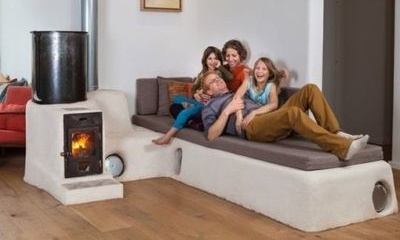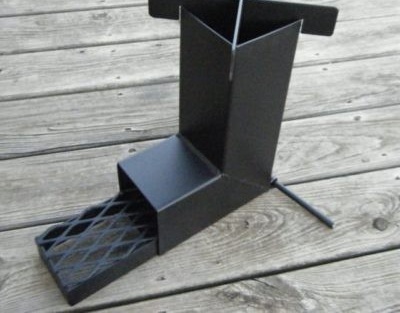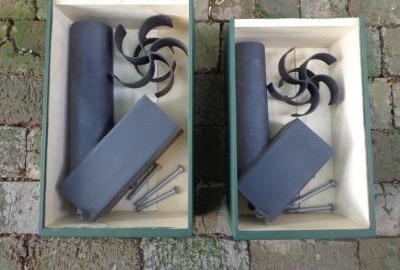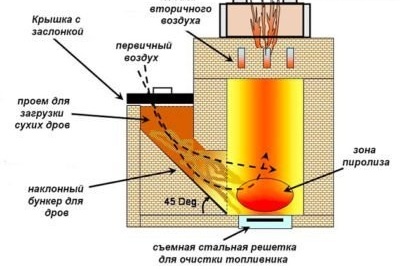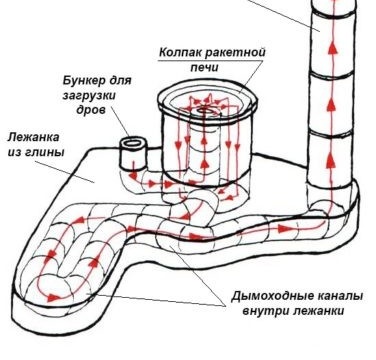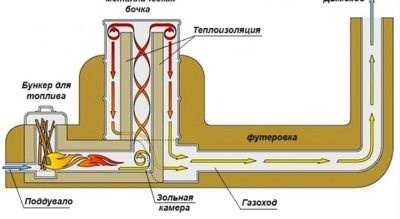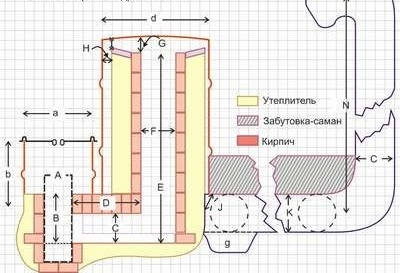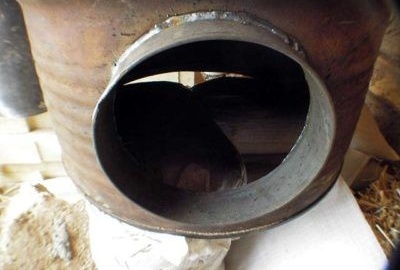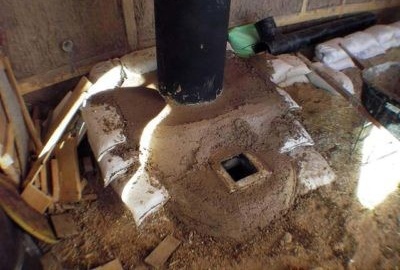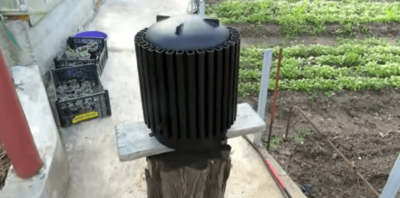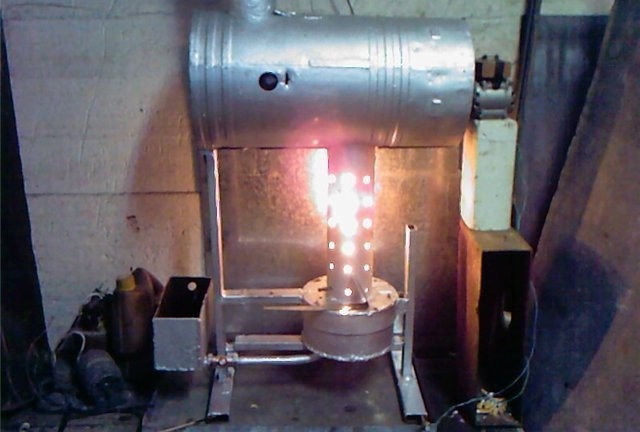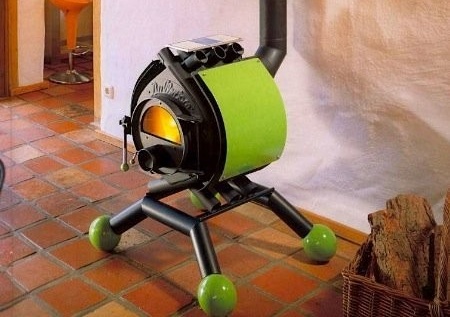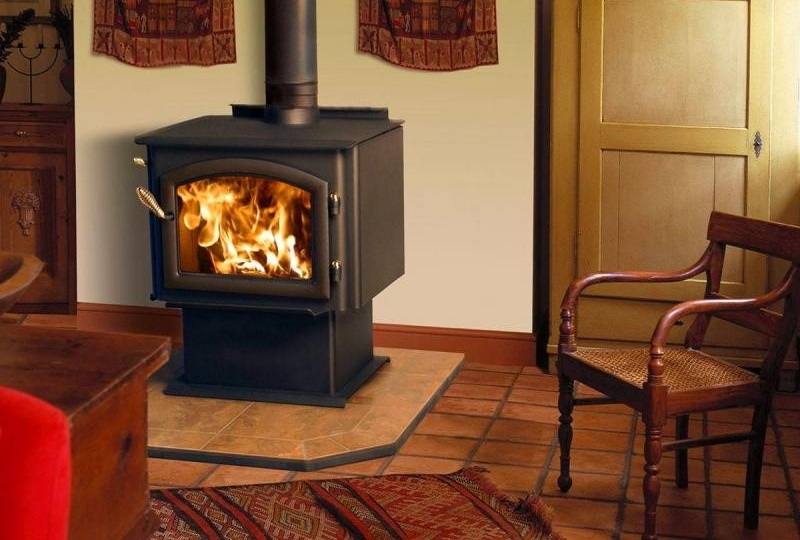Jet thrust on guard of cozy heat: do-it-yourself rocket stove

The simple and cheap design of the rocket furnace began its march around the world from North America, where it is still very popular in the countryside. They know her on all continents, including distant Australia. Enthusiast enthusiasts conquer the heating unit with simplicity and energy efficiency, which, combined with low cost, makes it extremely attractive for manufacturing at home. Of course, a large house cannot be heated with a jet stove, but in a country house or in a small garden house it will be more than appropriate. Surprisingly, it is a fact - we know about this amazing design. And this is in a country where the cold weather lasts longer than six months! Today we fill this gap and tell everything that we know about the warm and comfortable "rocket", including the smallest details of its manufacture with our own hands and the intricacies of operation.
Content
Jet furnace - what is it
Reactive, or, as it is also called, a rocket furnace, in fact, has nothing to do with modern technologies. The only thing that makes this heating unit look like space transport is the intense flow of flame and the buzz associated with improper operation. Nevertheless, it cannot be said that the rocket furnace is a completely technical backward device. Despite the simple design, it uses the most advanced solid fuel combustion methods:
- pyrolytic combustion of gases released during the dry distillation of solid fuel;
- the movement of gaseous products through the channels of the furnace, which does not require forced ejection due to traction.
The simplest "rocket" is a curved section of a pipe of large diameter. Firewood or other fuel is laid in a short horizontal section and set on fire. At first, the heating device works like the most ordinary stove, but this is only until the temperature of the longer vertical part, which acts as a chimney, rises. Red-hot metal promotes the re-ignition of combustible substances and the appearance of rarefaction at the upper point of the chimney. Due to increased traction, the flow of air to the wood increases, which significantly increases the intensity of combustion.In order to achieve even greater efficiency from this original device, the furnace opening is equipped with a door. When the cross section of the air channel decreases, the supply of oxygen to the wood stops and their pyrolytic decomposition into gaseous hydrocarbons begins. It’s just that they will not be completely burned in such a simple installation - for this it will be necessary to equip a separate zone for the afterburning of flue gases. By the way, it is this, as well as the thermal insulation of the chimney, that allows more complex "missiles" to successfully compete with other solid fuel units. As for the simplest design we are considering, it is often used for cooking or heating food. All that is required is to equip a convenient platform for a pot or kettle on the vertical section of the furnace.
Geography of use of rocket heating units
Being a simple and convenient heating and cooking unit, the rocket furnace is widely used both in mobile and stationary versions. Most often it is used:
- for heating residential premises;
- as equipment for drying fruits;
- for heating greenhouses;
- to ensure normal working conditions in workshops or garages;
- to maintain positive temperature in warehouses, in household units, etc.
Due to its simplicity, unpretentiousness and reliability, a jet heater enjoys well-deserved respect among fishermen and hunters, lovers of motor rallies and survivors. There is even a special performance, the name of which speaks of its purpose - “Robinson”.
Advantages and disadvantages of the rocket furnace
Despite the uncomplicated design, the rocket furnace has a lot of advantages:
- coefficient of performance at the level of the best examples of modern solid fuel heating equipment;
- profitability - to achieve the required temperature, the reactive unit will use four times less firewood than a traditional design stove;
- heating temperature above 1000 ° C;
- the possibility of using solid fuel of any type, including dry vegetable waste, cones, needles and shavings;
- completeness of combustion and environmental friendliness - during operation, the flame temperature rises so much that soot ignites. The smoke of a rocket furnace consists mainly of water vapor and carbon dioxide;
- the possibility of reloading fuel for continuous operation of the heater;
- simplicity and reliability;
- the presence of portable structures designed for mobile use.
The heating unit is not without its drawbacks. Operation of the device is associated with the risk of carbon monoxide entering the home. The stove cannot be used for heating a large house, and attempts to install a water heat exchanger in the combustion zone lead to a decrease in thermal power and a violation of normal operation. The disadvantages include the low aesthetic value of the design, which, however, is a very ambiguous statement, since for lovers of ethno-style the design of the stove is a real find.
Types of jet heating appliances. The choice of design for self-manufacturing
Craftsmen have developed several designs of rocket furnaces suitable for mobile or stationary use:
- portable units made of metal pipes, cans or buckets;
- jet heating appliances from a gas cylinder;
- stoves built of fireclay bricks and metal tanks;
- heating heat generators with a stove bench.
The most difficult to manufacture are structures, the construction of which requires the skills of a bricklayer. Nevertheless, in the presence of detailed schemes of ordinal layouts, even a novice home master will cope with this work.
Portable rocket furnace
Campaign options are represented by the simplest designs, which are based on the same pipe bent or welded from separate segments. The improvements concerned only the installation of a partition for arranging an ash pan, in which a slot is made for air intake. Often, the lower part of the loading chamber is equipped with a grate for supplying air directly to the combustion zone. The firewood doorway is equipped with a door, which subsequently regulates the air supply.
The requirements for a mobile design also extend to convenience during cooking, so the top cut of the chimney must necessarily be equipped with a stand for metal utensils.
Gas cylinder assembly
The use of a gas cylinder is the next step in the development of jet heating appliances. A more complex design can significantly increase the thermal power and efficiency of the furnace. All that is needed for the installation is a household gas cylinder or fuel barrel, pieces of thick-walled steel pipes and a metal sheet 3-5 mm thick.
If there is a piece of steel pipe with thick walls and a diameter of more than 30 cm, a rocket furnace can be made from it. This option will avoid the time-consuming operations associated with the dismantling of the factory gas tank.
How this design works can be seen in the above diagram. Firewood loaded in the firebox is burned due to the inflow of air through the loading window. The burning of combustible gases takes place in a pipe installed inside the cylinder due to the supply of secondary air. To enhance the effect, the inner chamber is insulated, due to which it is possible to raise the temperature inside above 1000 ° C. Hot gases in the direction of travel hit the hood and enter the outer chamber, the walls of which act as a heat exchanger. Having given their energy, the combustion products are discharged through a chimney cut into the lower part from the back of the cylinder.
To create the traction necessary for the stable operation of the rocket furnace, the top of the chimney is raised by at least 4 m relative to the loading window.
Combined brick and metal barrel rocket kiln
The use of fireclay bricks for arranging a firebox and internal chambers of a jet heating device transfers the "rocket" to the category of stationary structures. The high heat capacity of the materials used allows you to accumulate heat and give it away for several hours, therefore, such units are often installed in residential premises.
Jet stove with a stove bench
Like other solid fuel furnaces, the "rocket" has the disadvantage that most of the heat goes through the chimney. Despite this, the individual advantages of its design make it easy to get rid of this minus. The thing is that the unit was called reactive for a reason, but because of the high rate of excision of burning gases. It is precisely this feature of it that can be wrapped up for the benefit by significantly increasing the length of the smoke channels.
This idea was realized in massive stationary structures with a couch in the form of a sofa or bed. It is successfully made of brick or rubble, decorating with a plastic mass of clay and sawdust. Due to the high heat capacity of the materials used, the furnace can retain heat all night, which, combined with high efficiency, makes the heating unit very attractive for installation in residential premises.
When choosing a design for manufacturing at home, it is necessary to take into account the features of its operation.A mobile installation is chosen as a hiking option - it will be enough to warm up, dry clothes and cook dinner. In order to occasionally heat small technical rooms, a portable gas cylinder design is used. If you want to heat a small country house or cottage, then there is simply no better option than a reactive heating unit with a stove bench.
DIY do-it-yourself rocket stove
The design proposed for self-manufacturing is an elite of rocket heating appliances. After construction, for a long time it will delight the owner with comfort and cozy warmth even in the most severe frost. As you can already guess, we are talking about a unit with a stove bench. Despite the fact that such a design is the most complex, the schemes, instructions and descriptions presented by us will allow you to build a furnace in just 2-3 days.
The device and principle of operation
A rocket furnace consists of several chambers and channels. The bunker for loading firewood is made of fireclay bricks and is equipped at the bottom with an opening for air supply. It has a refractory lining and a channel that connects the firebox with a vertical gas duct (flame tube or riser). As a casing of the rocket furnace, a metal barrel is used, inside which a afterburner is laid out with magnesite or chamotte brick. The heat exchanger of the heating unit is not only a steel tank, but also long horizontal channels of the bed, made of galvanized steel pipes or bricks.
There is no need to use refractory materials for arranging heat exchange channels. Fairly well-burnt red brick.
The body of the stove and trestle bed is formed of sandbags, stone or brick debris and coated with a clay compound. The good heat storage ability of finishing materials allows the structure to give off heat for several hours after the wood has completely burned out. To remove the products of combustion, a high chimney is used, which can pass both indoors and outdoors.
The high performance of the “rocket” is explained by the method of burning fuel, which gravitates not so much to direct-flow heating units as to pyrolysis boilers. The operation of the furnace is accompanied by the active release of gas components that are burned in the riser. The cap helps to reduce the flow rate of hot gases, otherwise they simply would not have time to oxidize. By the way, heating the upper part of the flame tube creates a vacuum at its end, due to which the active combustion of fuel occurs. At the same time, such a high temperature arises in the riser that even soot is ignited. Nevertheless, at the place of transition from the vertical channel to the horizontal heat exchanger, experts recommend installing an ash pan, equipping its chamber with a small door for the possibility of periodic maintenance.
Calculation of the main parameters, drawing
It is not necessary to give the exact dimensions of a rocket furnace with a stove bench - its dimensions and configuration completely depend on the characteristics of the room. The presented method for calculating parameters based on the use of proportions of all parts of the rocket furnace will be quite enough to design a high-performance, efficient unit.
To perform the calculation, it is enough to know the diameter D and the height H of the external heat-exchange casing (drum).
- The height of the flame tube is at least 1.3H.
- The gap between the riser and the cap is 0.1–0.15H.
- External clay coating is performed no higher than 1 / 3H.
- The thickness of the heat storage layer should be no more than 1 / 3D.
- The cross section of the flame tube is 0.25–0.3D.
- Ash pan height - up to 10% of the vertical dimension of the casing.
- The cross-section of the blower should be 50% less than the area of the riser.
- The thickness of the adobe cushion above the heat exchanger is at least 1 / 4D.
- The height of the chimney is more than 4 m.
- The length of the horizontal heat exchanger is calculated based on the volume of the drum. In the case of using a standard fuel barrel, it can reach 6–8 m.
As you can see, it is not difficult to determine the dimensions of all elements of the furnace, especially since its design allows for some liberties in terms of dimensions and configuration.
For perfectionists and those who are afraid to experiment, we give a drawing of a heating unit, made on a scale on a marked sheet of paper. If necessary, removing the exact dimensions from it is not difficult.
Materials and tools
The construction of a jet furnace does not require any specific devices. Of a power tool, only a welding machine and a grinder will be required in the course of work, and even then just for a few minutes - to separate the barrel lid and configure the heat exchanger pipes. Everything else can also be found in any host:
- trowel (trowel);
- bushhammer;
- construction level and plumb;
- roulette;
- capacity for solution preparation;
- bayonet shovel;
- tamper;
- buckets;
- iron for concrete.
Although the design of the "rocket" and undemanding to materials, still some of them have to buy. Here is a list of what is required during the construction process:
- refractory brick of any type;
- metal barrel for the manufacture of a casing;
- pipe Ø30–40 cm, which will hold the thermal insulation coating of the vertical channel. You can use the housing from the old water heater, a suitable capacity of the industrial receiver or accumulator;
- galvanized steel pipes with a diameter of more than 25 cm, which will be needed as a heat exchanger;
- a steel pipe for arranging a chimney with a diameter of 150 mm and a bend for its removal by 90 °;
- ash pan hatch;
- blowing door;
- special heat-resistant mixture for the preparation of the solution (can be replaced with sand and clay);
- perlite for thermal insulation of a riser;
- Red brick;
- rubble stone or brick waste;
- sawdust or chaff.
Since the barrel will only be partially embedded in the furnace, it will have to be painted to increase the aesthetic value of the unit. To do this, you will additionally need a brush for metal, a solvent to degrease the metal surface, primer and any heat-resistant paint.
Site selection and other preparatory activities
When determining the construction site, the requirements that apply to all designs of open-flame solid fuel furnaces should be taken into account:
- the area of the room in which it is planned to install a jet heater with a sunbed, should be at least 16 m2;
- the absence of logs (floor beams) under the furnace body will greatly simplify installation;
- wooden rafters and ceilings should not be above the hearth;
- if part of the chimney passes through the ceiling, then the stove is installed closer to the central part of the house. In this case, the pipe can be fixed near the ridge;
- It is not necessary to install a heating structure close to the outer contour of the building - precious heat will go to the street. It is better to attach the unit to one of the internal piers;
- It is not recommended to build a jet device near wooden walls and partitions. In this case, select a separate placement.
It is also important how convenient it will be to kindle a stove-rocket and toss firewood into it. For this, the firebox is placed towards the entrance, providing at least 1 m of free space in front of it.
In a small room it is convenient to place the rocket furnace in the corner, orienting the loading hopper in one direction, and the lounger in the other.
Having chosen a place, they begin to prepare it for future construction. If the room is equipped with a wooden floor, then that part of it that will be under the stove is removed. After that, they dig a shallow foundation pit, the bottom of which is compacted using a rammer.
In addition, it is necessary to prepare a metal barrel for installation. To do this, cut off its cover along the contour. In this case, part of the thickening in the form of a metal hoop is left to provide rigidity to the base of the casing. Most likely, the fuel tank will be dirty and rusty, so it’s better to clean it before installation.
The last thing to do before starting construction is to prepare a solution. It is best to use a special heat-resistant composition, which can be bought at construction stores, but you can get by with a simple mixture of sand and clay in a ratio of 1: 1 or 1: 2, depending on the fat content of the latter. Water will be needed up to ¼ of the volume of dry components - the output should be a composition resembling thick sour cream.
Instructions for the progress of work
As already mentioned, to make a rocket stove with a stove bench, it will take a lot more effort and time than in the manufacture of a metal unit. Step-by-step instructions with illustrations of all stages of construction will help ease the task and reduce time.
- The place where the firebox will be formed is deepened by 10 cm and laid out with refractory bricks, after which the formwork is installed along the furnace circuit. To strengthen the foundation, it is necessary to install reinforcement from building mesh, reinforcement Ø10–20 mm or scraps of metal pipes and corners.
- The level lay the base of the working chamber.
- The structure is poured with concrete. Further work can be started immediately after setting the solution. As a rule, one day is enough for this.
- Continuous-laid refractory bricks form the base of the jet furnace and the combustion chamber.
- The walls of the structure are raised in several rows of masonry.
- Equip the lower channel of the heat-generating rocket.
- The combustion chamber is blocked by a series of bricks laid across so as to leave two openings - a furnace and a riser (vertical channel).
- Prepare for installation the old housing from the accumulative type boiler. To do this, the device is cut from two sides to get a large diameter pipe.
- The lower part of the tank from the fuel and lubricants is equipped with a flange, which will include a horizontal heat exchanger pipe. Welds should be continuous to ensure tightness and, consequently, the safety of the structure.
- After the outlet pipe is cut into the barrel, it is cleaned of rust, covered with a primer and several layers of heat-resistant paint.
- A side outlet, acting as an ash pan, is welded to the horizontal chimney. To clean it, the channel is equipped with a sealed flange.
- A fire tube is laid out of fireclay bricks. The shape of its inner channel is a square with a side of 18 cm. During operation, the vertical position of the structure must be monitored using a plumb line or building level.
- A casing is installed on the heat pipe, after which the gaps between the metal container and the walls of the vertical channel are filled with perlite.To avoid spilling thermal insulation on the floor, the lower part of the riser is carefully sealed with a clay mixture.
- Make a cap firebox. In its quality, you can use the cut off part of the water heater, equipping it with a convenient handle.
- Using brick or masonry, the furnace body is formed. For this purpose, you can use sandbags, laid at the base of the vertical channel.
Unpretentious appearance is hidden by adobe coating. For its manufacture, up to 50% of large sawdust or chaff (sex) is introduced into the clay solution.
Additives in the clay mixture play the same role as crushed stone in concrete. They are needed so that when drying and subsequent work with variable heat loads, the furnace surface does not crack.
- The perlite backfill from above must also be sealed with a coating.
- Form the front of the furnace. To do this, in any suitable way (brick or masonry, sandbags, adobe) lay out the contour of the furnace. The inner part is filled with crushed stone, and the upper one is given the desired shape, using the adobe mixture.
- An external casing of a metal barrel is installed on the prepared base, orienting the container with the lower pipe in the direction of the bed. The lower part of the tank is sealed with clay.
- Using a corrugated pipe, a channel is connected to the firebox, which connects the firebox to the external atmosphere. If it is not installed, the stove will consume warm air from the room, which will be replaced by cold masses coming from outside. From the furnace side, the channel will need to be closed as soon as the firewood is completely burned out. This will not allow air from the street to enter the heat exchange channels.
- To test the operation of the rocket furnace, the first kindling is carried out, during which they are convinced that the gases freely escape into the horizontal chimney.
- Heat exchanger tubes are attached to the lower pipe, which are mounted on a base formed of red brick.
- Install the chimney. All connections of parts of the horizontal and vertical channels are sealed with an asbestos cord and a refractory coating.
- Using the same method as in the manufacture of the furnace body, attach the desired configuration to the stove bench.
- The barrel can be completely covered with adobe, leaving only a horizontal platform open, which is convenient to use for heating food.
- The chimney brought out is equipped with a condensate trap and tar trap, and the upper cut is protected from precipitation with a cap.
Tests of the rocket furnace are carried out only after the complete drying of the adobe coating. Otherwise, the decorative coating may crack.
For the safe operation of the rocket furnace, the room must be equipped with carbon monoxide sensors.
Modernization of the rocket heat generator
To expand the scope of reactive heating furnaces, they are being finalized, increasing the convenience and versatility of the design. The platform intended for cooking in mobile structures is often replaced with a full-fledged stove. It is convenient to use such a hob on your own compound for household purposes - for preparing food for pets or during the preservation of blanks for the winter. A feature of this type of rocket furnace is a wide and flat horizontal channel into which hot gases from the nozzle are directed. Passing under the surface of the stove, they heat it red-hot, and then go into a vertical chimney.Comfortable legs give stability to the structure, and the original shape allows you to use the unit as a stand or table at a time when it is not used for its intended purpose.
A liquid heat exchanger cannot be installed in the flame tube of a jet furnace, but this does not mean that it cannot be used as a heat generator for a water heating system. To do this, the "rocket" is equipped with a kind of contour of radiator plates, which create a kind of maze in the afterburning zone. Thanks to their heating, heat is removed from the afterburner to the water jacket. The efficiency of the unit depends on the area and heat capacity of the plates, so they are performed in the form of massive metal strips up to ¾ section of the heat channel. I must say that such a heat exchanger is best used to produce hot water using the rocket furnace itself in the traditional way.
The original design has a convector rocket oven. To increase heat transfer, vertical tubes are mounted on the surface of the outer casing, which play the same role as the air channels of buleryan. Cold air is trapped at the bottom of the tubular heat exchangers and heats up as it moves up. This ensures forced convection, which further increases the thermal efficiency of the installation.
Features of the use of jet furnaces
Being a system of long burning, the rocket furnace requires preliminary heating before operation. As a rule, no one complies with this requirement in mobile installations - they consume little fuel, and the potbelly stove itself is most often used on the principle of “works, and okay”. In stationary structures, warming up the furnace before starting it is extremely important, since with a cold flame tube there is no question of any afterburning. Firewood will be burned without giving up heat, and the chimney will very quickly become covered with soot, tar and creosote.
The heating of the furnace is carried out using chips, paper or shavings, which are loaded into the firebox and set on fire. The output of the operating mode is judged by a buzz in the heat channel. Strong sound indicates inefficient operation of the unit. As soon as the rumble begins to subside, we must begin to lay the main fuel. Blowing in the first 10-15 minutes should be completely open. Then the air supply is reduced, focusing on the sound of the furnace - it should "rustle" or "whisper". After burning wood, the air channel of the furnace is covered to prevent leakage of heat from the room. Once every 2-3 days, ash is removed, for which they use a metal scoop and poker.
Maintenance of a jet furnace is carried out no more than once a season. To do this, open the ash pan door, through which the remnants of soot are removed. If necessary, clean the smoke channel using the hatch of its trap. I must say that the proper operation of a jet heater never leads to smoke in the room. All that is required of the owner for this is to follow the recommendations on the use of the "rocket" and not to neglect safety regulations.
Do-it-yourself rocket stove: subtleties and nuances of construction (video)
Unique technical characteristics, almost zero cost and availability of materials for construction cover all the shortcomings of a jet furnace. If you wish, you can build a full-fledged heating device over the weekend, including arranging a comfortable bed. "Rocket" is also convenient because it does not require high qualification of the stove-maker, and in the external design it allows the realization of even the most unusual design idea.
